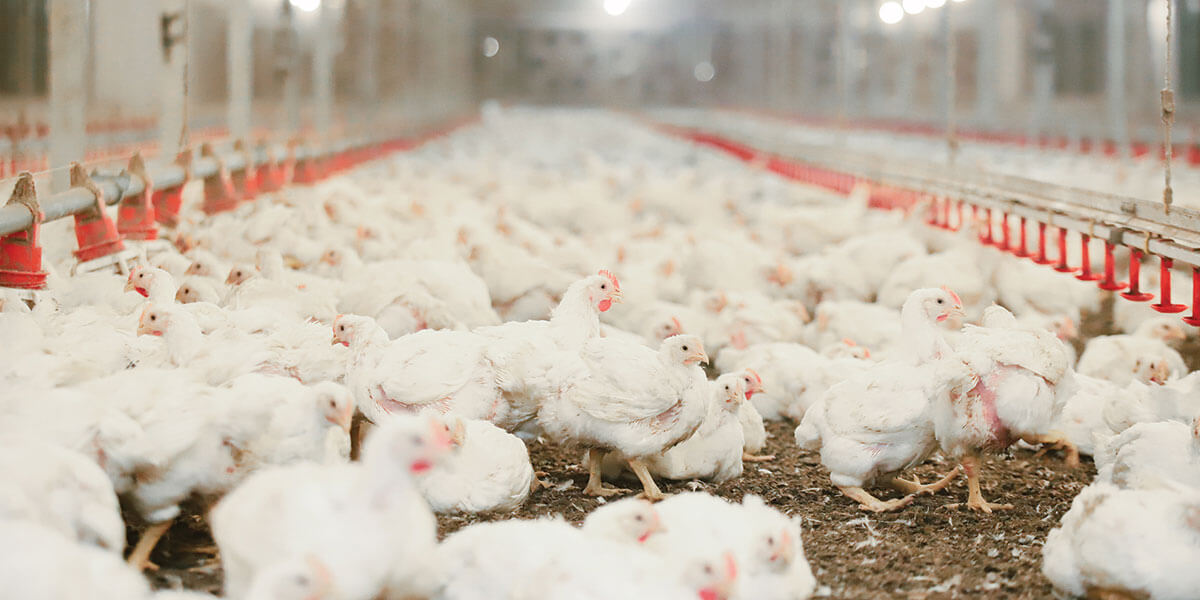Mycotoxins are estimated to affect 25 percent of the world’s crops and can cost an estimated at $466 million USD, while production losses tied to mycotoxins approach $6 million USD annually (CAST, 2003). When mycotoxins are present in poultry feedstuffs, it can have negative health and production effects, ranging from acute to chronic diseases, altered growth patterns, reduced production and reproductive efficiency, and susceptibility to infectious diseases.
How Mycotoxins Are Produced and Where They Can Be Found
There are five major groups of mycotoxins:
- Aflatoxins (AF)
- Trichothecenes, including deoxnivalenone (DON), diacetoxyscirpenol (DAS), T-2, HT-2 and over 170 other molecules
- Fumonisins (FUM)
- Zearalenone (ZEA)
- Ochratoxin A (OTA)
Aflatoxins and OTA are considered storage mycotoxins because they are primarily produced after harvest, during the storage phase. These mycotoxins are less common when improving storage practices.
Trichothecenes, FUM and ZEA are considered field mycotoxins because they are primarily produced while crops are growing in the field. These are found in feedstuffs more frequently due to uncontrollable weather conditions.
Corn, wheat, barley, bran, distillers’ dried grains with solubles and peanut meal are the most common mycotoxin-contaminated feedstuffs in poultry diets. When crops are contaminated while growing in the field, it is likely that several mycotoxins will be present at the same time. For example, if you find DON in a corn sample, it is likely that you will also find ZEA and FUM in the same sample because they are produced by the same genus — Fusarium.
Mold can also be found in poultry litter if the litter gets wet and, in some situations, can produce mycotoxins. Mold can be present anywhere and can survive a wide temperature range from 23 to 122°F (-5 to 50°C). High humidity also creates favorable conditions for mold growth.
Mycotoxins Reduce Feed Intake, Increase Trace Mineral Requirement
Mycotoxins can lead to decreased feed intake, liver failure and gastrointestinal epithelial tissue damage. This will decrease nutrient absorption, reduce a bird’s ability to mount a robust inflammatory response to immune challenges, and decrease the amount of energy available for health maintenance, leaving birds more susceptible to disease.
In laying hens, mycotoxins decrease egg production and eggshell quality. The effects are the same in breeders. Since AF and DON can be transferred to the egg, it can impair the formation of blood vessels and cause early death for embryos. In broilers, mycotoxins decrease growth and reduce carcass quality by making birds more susceptible to bruising and bleeding in the muscle tissue.
Overall, mycotoxins in feed increase the trace mineral requirement of animals, particularly those anti-oxidative minerals such as Zn, Mn and Se. Aflatoxins, DON and FUM cause damage to intestinal epithelial tissue and may reduce the absorption of nutrients, including essential trace minerals which are required in increasing quantities during a mycotoxin challenge. Supplementation with Zn, Mn, Cu and Se is required to repair damage to cell membranes and to counteract the oxidative stress caused by mycotoxins.
How to Identify Mycotoxins in Poultry Feed Supply
Looking for visual signs of mycotoxins is an unreliable strategy. Sometimes you can see mycotoxins if your poultry feed is really moldy, but the presence of mold doesn’t necessarily guarantee the presence of mycotoxins. On the other hand, grains that are clean and free of mold could have mycotoxins present, even at high levels.
The only way to truly identify if mycotoxins are present, and at what level, is to take samples and send them to a lab for chemical analysis. Be sure to collect samples from 10 to 20 points throughout your poultry feed supply as there may be spots with high contamination levels, and some with no mycotoxin contamination at all.
Mycotoxin Feed Management Tips
If mycotoxins are detected in your feed ingredients, there are three potential approaches you can take:
Option 1 — Eliminate the contaminated feedstuff. This is the ideal option. The problem is producers and nutritionists are often not in a situation where eliminating the feedstuff is an option, and very often the producers and nutritionists cannot find clean feedstuff without any mycotoxin contamination.
Option 2 — Reduce the feeding rate of the contaminated feedstuff. This option allows the producer and nutritionist to blend the contaminated feed with non-contaminated feed to reduce the mycotoxin contamination to an acceptable level. Even at a very low amount, however, mycotoxins will have a negative impact on immunity and health of an animal, but this point is often overlooked.
Option 3 — Use a research-proven mycotoxin sequestering agent to decontaminate the feed. Producers and nutritionists can blend a mycotoxin sequestering agent into the contaminated feed. The mycotoxin sequestering agent will bind the mycotoxin to the agent, making it inert and preventing it from being absorbed by the animal. However, producers and nutritionists may still need to implement Option 2 as part of Option 3 for improved response.
Controlling Mycotoxins
The best way to control mycotoxins is to prevent them from contaminating the feedstuffs at the point of production. In some circumstances, drought or high levels of precipitation that cause fungal diseases cannot be avoided. However, management of the growing crop can help to reduce the levels of mycotoxins. Important considerations are management of the soil, crop rotations, variety selection, fungicide application and reducing soil contamination during storage.
Sequestering Agents Impact Mineral Utilization
While mycotoxin sequestering agents are somewhat effective in controlling the mycotoxins, some classes of mycotoxin sequestering agents may also bind trace minerals, rendering them unavailable for absorption and metabolism. One way to overcome this potential and unintended consequence is to feed Zinpro Performance Minerals. Performance trace minerals, including Zinpro® Availa® Zn, Zinpro® Availa® Mn, Zinpro® Availa® Cu, Zinpro® Availa® Fe, Zinpro® Availa® Se and Zinpro® Availa® ZMC feature a trace mineral bound to an essential amino acid in a unique manner, which maximizes stability and absorption. This trace-mineral-to-amino-acid bond will not be impacted by a mycotoxin sequestering agent, allowing the trace minerals to be better absorbed and metabolized by the animal.

